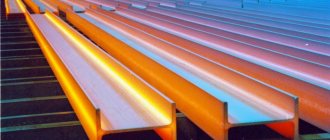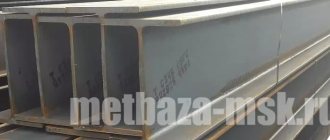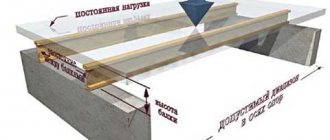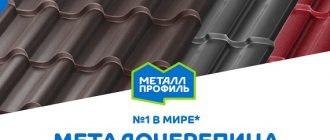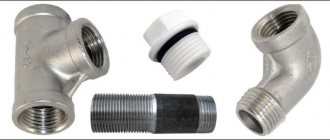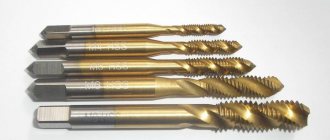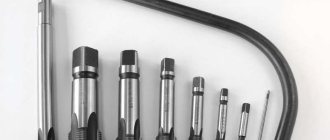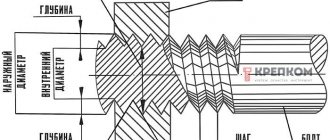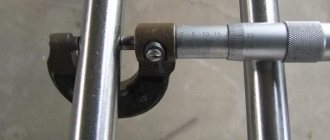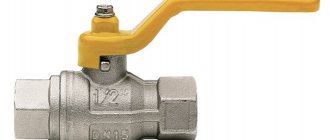I-beam: table of dimensions, weight and technical characteristics - this is the data that will definitely be useful in the construction of civil and industrial facilities. I-beams are quite varied in their design. This article provides information about the advantages of profiles made of different materials, their sizes and modifications.
The specific shape of the I-beam increases the strength and rigidity of the product, and also allows it to withstand increased loads
Features of the I-profile design
An I-beam is a standard beam with a cross-section shaped like the letter “H”. Modern construction of bridge structures, floors, multi-story buildings or hydraulic structures is impossible without the use of this type of profile. It is also widely used in mechanical engineering.
Since I-beams are a building material that is used in critical structures, their production is carried out strictly in accordance with state standards
An I-beam profile is a type of rolled metal product made from high-quality profile steel. As a rule, structural steel without or with low alloying additives is used in the production of products.
I-beams have different weights and dimensional characteristics. To classify profiles, appropriate numbering and markings are used. This facilitates the process of selecting materials, taking into account the characteristics of the facility under construction and the expected loads on the structure.
It is difficult to underestimate the benefits of using I-profiles. These products, used in various fields, are resistant to high loads and impervious to external influences. They are durable, reliable, and affordable. The pricing policy of the products is also pleasing. The cost of the structures, compared to analogues, is modest, which is undoubtedly a plus.
When buying I-beams, you should definitely pay attention to their number; you can use it to find out the profile height
Wooden I-beams, the sizes of which are also varied, are widely used in frame house construction. The use of profiles from this material allows you to reduce costs when laying the foundation, speed up the construction time of the structure, and also significantly reduce the overall weight of the building. The use of I-beams made of wood eliminates future problems associated with shrinkage, shifts, and shrinkage of the structure. A self-made wooden I-beam allows you to avoid the creaking of the finished structure, unsteadiness and vibrations inherent in ordinary frame buildings.
Important! Carbon steel beams are designed for indoor use where exposure to adverse weather conditions is excluded. For outdoor work or with increased requirements for structural strength, beams made of low-alloy steel should be used.
Features of manufacturing I-profiles
I-beam profiles are produced in accordance with approved regulatory documents. GOST 26020-83 defines the issues associated with the production of profiles with parallel edges. Aspects of manufacturing profiles for specialized purposes are regulated by GOST 19425-74. Features of making profiles with inclined edges are indicated in GOST 8239-89.
The production of an I-beam is carried out by welding three main elements, resulting in belt seams
Making an I-beam from metal with your own hands is almost impossible. The production process is carried out on specialized equipment using the hot rolling method. The blanks for the product are blooms, which are processed at a temperature of about 1200 ℃. The specific profile shape increases the strength and rigidity of the product, and also allows it to withstand increased loads and distribute it evenly over the entire surface of the structure.
There is another method for producing I-profiles - welding, when three profile elements are connected by welding. This process is fully automated. Welded I-beams have a smaller cross-section compared to monolithic beams. Also here you can combine different grades of steel, strengthening only the “necessary” areas, which, in turn, allows you to reduce the overall cost of the profile.
I-beam 10: dimensions, characteristics, scope of application
I-beam profile No. 10 is the smallest representative of these structures. Despite the small weight, the product is quite rigid. This profile is characterized by increased resistance to loads, high reliability and stability of geometric characteristics during operation.
I-beam profile No. 10, being light in weight, is quite resistant to shock and weight loads
I-beam 10 is used as a strong ceiling for frames in the construction of low-rise structures, strengthening structures or for erecting supports, and the product is also used in the design of vertical columns. The parameters of this profile are small. The total height of the I-beam is 100 mm. The width of the profile reaches 55 mm. The wall has a thickness of 4.5 mm, and the shelf is 7.2 mm. A meter of I-profile in this modification weighs 10 9.46 kg. The tenth I-beam can be made from 4 m to 12 m in length.
According to the position of the edges, inclined and parallel I-beams are distinguished. They are marked accordingly, where “U” is a profile with sloped edges and “P” is a beam in which the edges are parallel.
I-beam 12: profile dimensions and weight, markings
This type of profile is manufactured in accordance with the provisions of GOST 8239-89. It is presented in several variations. The marking determines the features of the product. Thus, the letter “B” denotes the edges of shelves without slope on standard I-beams. The marking “Ш” indicates the parallelism of the edges of the shelves on wide-flange profiles. The letter “K” characterizes column I-beams. Narrow flange profiles are marked “U”, and medium flange beams have the index “D”.
Compared to No. 10, I-beam No. 12 is able to withstand greater load-bearing loads, deflections and compression
The total height of the size 12 profile is 120 mm. Its total width is 64 mm. The thickness of the wall of the product is 4.8 mm, and the lintel is 7.3 mm. A linear meter of such an I-beam weighs 11.54 kg.
Important! The given dimensional data is for informational purposes only, they are for reference and are formed based on the nominal size with a metal density of 7.85 g/cm³.
Types of I-beams
Modern industry presents a huge variety of I-beams. Depending on the cross-sectional shape, they are divided into the following categories:
- Hot rolled steel I-beam GOST 8239-89. It is an H-shaped profile, the flanges of which form an angle of 8-12 degrees with the wall. Most often used as a support crane beam for hoist lines.
- The I-beams are normal. Their range is fully presented in the table of GOST 26020-83. It is distinguished from the previous type of profile by the parallelism of the edges of the shelves to each other. This simplifies the manufacturing process on the one hand, and on the other, although slightly, reduces the resistance to deformation of the profile. In design documentation it is usually designated by the letter “B”.
- Wide-flange I-beam GOST 26020-83. The width of the shelves in this profile is increased by almost 1.5 times compared to the above types of I-beam assortment. This increase in cross-sectional shape has a positive effect on the strength, rigidity and durability of the beam. On average, it can withstand 40% more load compared to a normal I-beam. Marked with the letter "Ш".
- Column I-beams have even wider shelf widths. The wall thickness has also been increased. The exact dimensions of the I-beam are given in GOST 26020-83. This modification allows you to increase the strength value by almost 100%. Used in particularly critical structures. Denoted by the letter "K".
In addition to the cross-sectional shape, the range of rolled profiles includes a different range of materials from which I-beams are made. The most used of them are:
- Carbon steels of ordinary quality. Mechanical properties and chemical composition correspond to GOST 380-2005. According to the degree of deoxidation, they are divided into calm, boiling and semi-calm. Eighty percent of the market is represented by these steels due to their optimal price ratio, technological and strength characteristics.
- Construction steels GOST 27772-88. They are distinguished by higher requirements in relation to the content of harmful impurities. The main range of these steels is represented by such grades as C235, C245 and C255.
- Low alloy rolled steels. A complete list of mechanical characteristics is available in the main table of GOST 19281-89. These steel alloys are additionally alloyed with manganese, silicon and aluminum, which makes them more resistant to dynamic loads.
- Steel for bridge construction GOST 4784-97. An even stronger alloy. Has increased resistance to cyclic loads. Used in particularly critical structures.
- Aluminum alloys GOST 4784-97. This includes their various brands: Amg5, D16 and others. They are used in cases where lightness is a priority for the design. Also, the range of I-beams made from this material is distinguished by higher aesthetic and corrosion-resistant properties.
Options
As stated earlier, the stiffness value of an I-beam is most influenced by the size and shape of the section, which are characterized by such parameters as:
- Height and wall thickness;
- Shelf width and thickness;
- The moment of resistance and the moment of inertia are quantities that show the resistance of the geometry of a shape to deformation. Their values can be found in the table of the reference book on material weights or other technical literature;
- Rounding radius.
The value of these parameters is selected based on the following technical conditions:
- Distance between supporting ends;
- Load type;
- The force on the beam is concentrated at one point or distributed over its surface;
- Load value;
- The type of material from which the beam is made.
Application area
The main industry for consuming I-beams is still construction. It is mainly used as span beams in industrial and civil premises. The I-beam is an important part of arched ceilings, bridge and gantry cranes.
The beam is also actively used in the construction of bridges and in the production of some special equipment: excavators, diggers and others. In the automotive industry, I-beams are used as an element of the frames of heavy-duty vehicles - trucks. They also serve as a supporting part of railway cars.
I-beam 14: dimensions and design features
I-beam profile No. 14 is manufactured in accordance with the provisions prescribed in GOST 8239-89. It is recommended for use in the construction of load-bearing structures in industrial and residential buildings, in the construction of bridges, as well as in the mechanical engineering industries. The material demonstrates high resistance to adverse environmental influences, fire resistance, and is also not afraid of various types of microorganisms. With the help of such structures it is possible to achieve a reduction in installation costs and a reduction in construction time.
The total height of this profile (including the thickness of the shelves) is 140 mm. The beam has a width of 73 mm, the lintel wall is 4.9 mm. The total thickness of the shelf reaches 7.5 mm. The weight of a meter I-beam is 13.68 kg.
I-beam 14, the dimensions of which are ideal for use in the construction of floors, is used in the creation of reinforced concrete structures with moderate and slightly increased loads
There are different types of I-beam of this type. I-beam table No. 14 clearly demonstrates this:
| Profile view | Width, mm | Height, mm | Shelf thickness, mm | Wall thickness, mm | Weight of 1 m length, kg |
| 14 | 73 | 140 | 7,5 | 4,9 | 13,68 |
| 14C | 80 | 140 | 9,1 | 5,5 | 16,9 |
| 14B1 | 73 | 137,4 | 5,6 | 3,8 | 10,5 |
| 14B2 | 73 | 140 | 6,9 | 4,7 | 12,9 |
Steel beam weight
When designing structures, it is important to calculate the load on the foundation and supporting structures. To do this, you need to know the weight of all elements. The weight of a linear meter of an I-beam is influenced by the type of steel used, the type of rolled product and the dimensions of the product. Using a special table, you can easily calculate the weight of a steel beam.
| I-beam weight table | ||
| Number | Weight of 1 meter, kg | Meters per ton |
| 10B1 | 8,1 | 123,46 |
| 12B1 | 8,7 | 114,94 |
| 12B2 | 10,4 | 96,15 |
| 14B1 | 10,5 | 95,24 |
| 14B2 | 12,9 | 77,52 |
| 16B1 | 12,7 | 78,74 |
| 16B2 | 15,8 | 63,29 |
| 18B1 | 15,4 | 64,94 |
| 18B2 | 18,8 | 53,19 |
| 20B1 | 22,4 | 44,64 |
| 23B1 | 25,8 | 38,76 |
| 26B1 | 28 | 35,71 |
| 26B2 | 31,2 | 32,05 |
| 30B1 | 32,9 | 30,40 |
| 30B2 | 36,6 | 27,32 |
| 35B1 | 38,9 | 25,71 |
| 35B2 | 43,3 | 23,09 |
| 40B1 | 48,1 | 20,79 |
| 40B2 | 54,7 | 18,28 |
| 45B1 | 59,8 | 16,72 |
| 45B2 | 67,5 | 14,81 |
| 50B1 | 73 | 13,70 |
| 50B2 | 80,7 | 12,39 |
| 55B1 | 89 | 11,24 |
| 55B2 | 97,9 | 10,21 |
| 60B1 | 106,2 | 9,42 |
| 60B2 | 115,6 | 8,65 |
| 70B1 | 129,3 | 7,73 |
| 70B2 | 144,2 | 6,93 |
| 80B1 | 159,5 | 6,27 |
| 80B2 | 177,9 | 5,62 |
| 90B1 | 194 | 5,15 |
| 90B2 | 213,8 | 4,68 |
| 100B1 | 230,6 | 4,34 |
| 100B2 | 258,2 | 3,87 |
| 100B3 | 285,7 | 3,50 |
| 100B4 | 314,5 | 3,18 |
In general calculations, the actual weight of the beam may differ from the theoretical values by 2-4%.
I-beam size 16, modifications and scope of application
The production of I-beams of this size is regulated by state standards. The scope of its application is quite wide: industrial and residential facilities, pavilions, columns, storage facilities, bridges, etc.
I-beam profiles No. 16 come in several types. It is technically possible to produce beams where the edges of the shelves are parallel, profiles with an inclination of the inner edge from 6% to 12% and with an inclination from 12% to 16%. Welded profiles are also produced, where the upper and lower flanges are attached to the base. As a variation of this profile, there is a non-standard I-beam, where the width of the upper and lower shelves is different.
I-beam 16, the dimensions of which are capable of providing high rigidity, is used for the construction of structures with long-term static and design loads
I-beams with a slope of up to 12% are a reinforced modification of the profile and are suitable for general use. Profiles with a slope of 12% are marked “M”. They are intended for use when installing overhead tracks. Profiles marked with the letter “C” are characterized by an inclination of the internal shelves of 16%. They are used to strengthen or reinforce mine shafts.
I-beam 16 has a total height of 160 mm. The total width of the beam is 81 mm. The thickness of the profile wall is 5 mm. The average shelf thickness is 7.8 mm. One meter of I-beam weighs 15.89 kg according to GOST.
I-beam profile No. 18: distinctive features and weight of the I-beam
This type of profile is classified as shaped rolled products - in the category of monorail beams. I-beam 18 is considered to be universal, since it is applicable in all branches of construction. Its main advantages are rigidity, strength, and wear resistance.
Like previous types of beams, I-beam No. 18 is manufactured in accordance with state standard 8239-89. This product is made in an H-shape and is available in two versions. There are I-beams of standard and increased accuracy. The standard precision profile has a height of 180 mm, a width of 90 mm, a wall thickness of 5.1 mm and an average lintel thickness of 8.1 mm. The weight of 18 I-beams in a meter beam is 18.35 kg. The high-precision beam is characterized by its distinctive features. The marking contains the letter “A”. The dimensions of I-beam 18 in this version are slightly different. The total profile height is 180 mm. The total width is 100 mm. The lintel has a thickness of 5.1 mm, the thickness of the shelf is 8.3 mm. I-beam No. 18 19.92 kg weighs.
I-beam No. 18 is used when laying the foundation, creating supporting areas, and also as reinforcing elements
Helpful advice! To quickly understand the profile markings, it is enough to know the principle of the inscription: the first numbers are the height of the profile, the letters are the type of beam and the number at the end is the size of the beam in this series.
Technical parameters, size and weight of I-beam 20
I-beam No. 20 is a profile made in the same hot-rolled method as other beams of this type. It is shaped like an inverted "H". I-beam profile No. 20 is produced in accordance with the provisions of GOST 26020-83, which regulates the size and weight of I-beam 20, as well as in accordance with state standards 19425-74 and 8239-89.
The total height of the profile is 200 mm, its width is 100 mm. The profile wall has a thickness of 5.2 mm, and the lintel is 8.4 mm. The weight of 1 meter of I-beam 20 is 21.04 kg.
Alternatively, such an I-beam can be made from welded beams. It is important to note that it has a wider scope of application.
I-beam No. 20 is intended for construction and installation work, for strengthening sections of the building body
Classification of profiles and possible sizes of I-beam 20
I-beams No. 20 may differ in the location of the flange edges. There are profiles with a slope and parallel. Faces with a slope are common (with an angle of 6-12%), i.e. without additional marking, and with a special location. The second option differs in the type of marking: M and S. Marking “M” assumes the use of the product when installing complex type hanging systems. The profile marked with the letter “C” is used in the construction of structures of complex geometry or in the formation of specific structures.
An I-beam profile whose edges are parallel is marked as “B”, “K” or “W”. It was mentioned above that the marking with the letter B is a regular profile. This type includes I-beam 20b1, the dimensions of which are as follows: the total width of the beam is 100 mm and the total height of the profile is 200 mm. The thickness of the walls of this design is 5.6 mm, and its shelf is 8.5 mm. A linear meter of profile 20B1 weighs 22.4 kg.
O stands for column profile and implies use in situations where the use of reinforced concrete columns is not possible. A profile marked “Ш” may well act as an independent component in construction. So, the dimensions of the 20sh1 I-beam according to GOST are as follows: height - 193 mm, and its width is 150 mm. The wall thickness of the beam is 6 mm, the lintel is 9 mm. A meter I-beam of this type has a mass of 30.6 kg.
Beams can be fastened with bolts, rivets or welded with a welding machine
Possible dimensions and weight of I-beam - table
The dimensions of I-beam 20 in length can vary from 4 m to 12 m. The size can be measured, unmeasured, multiple of measured and measured with remainder, where the remainder is a profile with a length exceeding 3 m. The table allows you to clearly compare the dimensional characteristics of each version of the I-beam:
| Profile view | Width, mm | Height, mm | Shelf thickness, mm | Wall thickness, mm | Weight 1 m length, kg |
| 20B1 | 100 | 200 | 8,5 | 5,6 | 22,4 |
| 20Ш1 | 150 | 193 | 9 | 6,0 | 30,6 |
| 20K1 | 200 | 195 | 10 | 6,5 | 41,5 |
GOST standards and assortment
- GOST 8239 89 for an I-beam tells about the range of hot-rolled steel I-beams with a slope of the internal faces of the flanges. The pages of the standard contain drawings of the cross section of the product, tabular reference data on maximum deviations in shape and rolling accuracy.
- An I-beam, the flange edges of which are parallel, made according to the standards of GOST 26020 831 (83), should vary in height from 100 to 1000 mm and have a flange width of 55 - 400 mm. The dimensions of I-beams are available in the table.
- A special-purpose I-beam with markings M, C and K (the product is intended for installation of overhead tracks, reinforcement of mine shafts) is manufactured in accordance with the requirements of GOST 19425 741(74). The standard also contains drawings, normative and reference materials. The I-beam must have the dimensions and weight described in the table, taking into account permissible errors.
| I-beam number | Dimensions | Cross-sectional area, cm2 | Weight 1 m, kg | Reference values | ||||||||
| h | b | s | t | R | r | XX | ||||||
| no more | Ix, cm4 | Wx, cm3 | Ix, cm | Sx, cm3 | ||||||||
| mm | ||||||||||||
| 10 | 100 | 55 | 4,5 | 7,2 | 7,0 | 2,5 | 12,0 | 9,46 | 198 | 39,7 | 4,06 | 23,0 |
| 12 | 120 | 65 | 4,8 | 7,3 | 7,5 | 3,0 | 14,7 | 11,50 | 350 | 58,4 | 4,88 | 33,7 |
| 14 | 140 | 73 | 4,9 | 7,5 | 8,0 | 3,0 | 17,4 | 13,70 | 572 | 81,7 | 5,73 | 46,8 |
| 16 | 160 | 81 | 5,0 | 7,8 | 8,5 | 3,5 | 20,2 | 15,90 | 873 | 109,0 | 6,57 | 62,3 |
| 18 | 180 | 90 | 5,1 | 8,1 | 9,0 | 3,5 | 23,4 | 18,40 | 1290 | 143,0 | 7,42 | 81,4 |
| 20 | 200 | 100 | 5,2 | 8,4 | 9,5 | 4,0 | 26,8 | 21,00 | 1840 | 184,0 | 8,28 | 104,0 |
| 22 | 220 | 110 | 5,4 | 8,7 | 10,0 | 4,0 | 30,6 | 24,00 | 2550 | 232,0 | 9,13 | 131,0 |
| 24 | 240 | 115 | 5,6 | 9,5 | 10,5 | 4,0 | 34,8 | 27,30 | 3460 | 289,0 | 9,97 | 163,0 |
| 27 | 270 | 125 | 6,0 | 9,8 | 11,0 | 4,5 | 40,2 | 31,50 | 5010 | 371,0 | 11,20 | 210,0 |
| 30 | 300 | 135 | 6,5 | 10,2 | 12,0 | 5,0 | 46,5 | 36,50 | 7080 | 472,0 | 12,30 | 268,0 |
| 33 | 330 | 140 | 7,0 | 11,2 | 13,0 | 5,0 | 53,8 | 42,20 | 9840 | 597,0 | 13,50 | 339,0 |
| 36 | 360 | 145 | 7,5 | 12,3 | 14,0 | 6,0 | 61,9 | 48,60 | 13380 | 743,0 | 14,70 | 423,0 |
| 40 | 400 | 155 | 8,3 | 13,0 | 15,0 | 6,0 | 72,6 | 57,00 | 19062 | 953,0 | 16,20 | 545,0 |
| 45 | 450 | 160 | 9,0 | 14,2 | 16,0 | 7,0 | 84,7 | 66,50 | 27696 | 1231,0 | 18,10 | 708,0 |
| 50 | 500 | 170 | 10,0 | 15,2 | 17,0 | 7,0 | 100,0 | 78,50 | 39727 | 1589,0 | 19,90 | 919,0 |
| 55 | 550 | 180 | 11,0 | 16,5 | 18,0 | 7,0 | 118,0 | 92,60 | 55962 | 2035,0 | 21,80 | 1181,0 |
| 60 | 600 | 190 | 12,0 | 17,8 | 20,0 | 8,0 | 138,0 | 108,00 | 76806 | 2560,0 | 23,60 | 1491,0 |
Taking into account the scope of application, the I-beam must have the dimensions and weight regulated by this document, taking into account permissible deviations. Otherwise, it will be difficult to talk about the reliability of constructed structures and structures, resistance to long-term multi-ton loads.
Technical characteristics and dimensions of I-beam 22
I-beam profile No. 22 is widely used in all branches of construction. It is often used as a supporting structure for a building under construction. The product is characterized by durability, long service life, and resistance to any weather conditions.
The dimensions of I-beam 22 differ depending on the type of product. Beams are manufactured in two variations - standard and increased precision. The standard precision beam has a total height of 220 mm. The total profile width is 110 mm with a thickness of 5.4 mm. The average thickness of the lintel is 8.7 mm. A linear meter of this modification profile weighs 24.04 kg.
I-beams No. 22 are manufactured in two variations - standard and increased accuracy
The height of the high-precision I-profile is 220 mm with a width of 120 mm. The profile wall has a thickness of 5.4 mm, and the shelf - 8.9 mm. A beam 1 meter long weighs 25.76 kg.
Note! I-beams No. 22 also vary in the degree of rolled strength. There are high (marking “A”), increased (index “B”) and normal (marking “B”) accuracy.
I-beam No. 24: characteristics and dimensions of the I-beam, its modifications
This profile, like other I-beams, is characterized by a number of advantages. Among them are reliability, long service life, and resistance to weather disasters. The use of I-beams eliminates the risk of structural destruction due to adverse environmental factors. It is carried out according to the criteria specified in GOST 8239-89.
The dimensions of I-beam 24 differ depending on the type of beam. The profile can be of normal or increased accuracy. The height of an I-beam of conventional accuracy is 240 mm. The shelf width is 115 mm, the walls are 5.6 mm with a shelf thickness of 9.5 mm. A meter beam of this type has a mass of 27.34 kg.
I-beam No. 24 is the primary type of steel structures that are used in the construction of both industrial buildings and civil buildings
The I-beam with the index “A” (increased accuracy) is 240 mm in height. The profile is characterized by a wider flange (125 mm) and a thick wall (5.6 mm). The thickness of the jumper has been increased to 9.8 mm. This beam weighs 29.4 kg.
An I-beam marked “M” (used for overhead track construction) has an internal face slope of less than 12%. The dimensions of the 24m I-beam are as follows: the total height of the beam is 240 mm, the total width is 110 mm. The lintel has a thickness of 8.2 mm, and the shelf is 14 mm. A meter beam of this type weighs 38.3 kg.
Characteristics and weight of I-beam No. 25
I-beam profile No. 25 is used in the construction of civil and industrial facilities, for the formation of load-bearing heavily loaded structures, structure frames, etc. It is made of unalloyed or low-alloy metal in various designs. It is quite natural that the dimensions of I-beam 25 in each version are slightly different.
25B1 – normal I-beam. The height dimensions of the I-beam 25b1 are 248 mm. The shelf width is 124 mm, thickness is 8 mm. The wall thickness is 5 mm. The meter profile weighs 21.3 kg.
I-beam No. 25 is made of unalloyed or low-alloy metal in various designs
25Ш1 – I-beam profile with wide flanges. The dimensions of the 25х1 I-beam are as follows: profile height – 244 mm, its width – 175 mm. The lintel has an average thickness of 7 mm, and the shelf - 11 mm. A meter beam of I-beam No. 25 weighs 44.1 kg.
The table of I-beams No. 25 of another modification demonstrates the dimensional characteristics of the product:
| Profile view | Width, mm | Height, mm | Shelf thickness, mm | Wall thickness, mm | Weight 1 m length, kg |
| 25B2 | 125 | 250 | 9 | 6 | 29,6 |
| 25K1 | 249 | 246 | 12 | 8 | 62,6 |
| 25K2 | 250 | 250 | 14 | 9 | 72,4 |
Types of rental:
- Normal - 30B1 and 30B2. Beam 30B2 has a more massive cross-section compared to beam B1 and can withstand greater loads.
- Wide flange - 30Ш1, 30Ш2, 30Ш3. Manufactured with increased width of shelves, used for creating columns and supports, for mounting guides. The higher the digital profile index, the more massive it is.
- Column - 30K1, 30K2, 30K3. In the cross section of these metal products, the height of the wall is equal (approximately or exactly) to the width of the shelf. The largest mass of 1 m in this series is the I-beam 30K3. Column series products are used for constructing columns and vertically positioned supports in the construction of multi-storey residential buildings and industrial facilities.
The regulatory document STO ASChM 20-93 was developed by the Association for Standardization of Products Manufactured at Ferrous Metallurgy Enterprises. It regulates the same types of I-beam number 30 as GOST 26020-83: normal, wide-flange, column. However, the section sizes vary slightly.
Profile features, dimensions and weight of I-beam 30
The production of I-profile No. 30 is regulated by the regulatory documentation mentioned above. These I-beams are produced in two modifications: a regular I-beam and an I-beam with increased accuracy (marked “A”).
It should be noted that the dimensions of I-beam 30, as well as profiles of other sizes, differ depending on the accuracy. The weight of the product also changes accordingly, which is of fundamental importance for some buildings.
Steel beam No. 30 is maximally resistant to deformation and can withstand enormous loads
A meter beam 30B1 weighs 32.9 kg. The dimensions of the 30b1 I-beam are as follows: the height of the metal beam is 296 mm, its width is 140 mm. The wall thickness is 4.8 mm, the shelf is 5.8 mm. The length of profile 30b1 ranges from 4 m to 12 m.
The dimensions of the I-beam 30w1 are different. The profile has a height of 291 mm, the width of the shelf is 200 mm, the thickness of the lintel is 8 mm and the thickness of one shelf is 11 mm. The beam length varies from 4 m to 13 m. A 1 meter long profile weighs 36.48 kg.
The high-precision I-beam profile has a height of 300 mm, a width of 145 mm, and a lintel thickness of 6.5 mm. The thickness of one shelf is 10.7 mm. At the same time, the mass of a meter high-strength I-beam is 39.17 kg.
The 30 cm beam is used in the construction of powerful lifting mechanisms, support structures and in the construction of mine shafts
Thirtieth I-beam: size table
I-beam profile No. 30 is used in the construction of large construction projects of complex architecture. Therefore, there are several “column” modifications of beams of this size. To be able to accurately determine the required materials, there is a convenient table: the weight of the I-beam and its dimensional characteristics are indicated for each type of specific profile.
| Profile view | Height, mm | Wall thickness, mm | Width, mm | Shelf thickness, mm | Weight 1 m length, kg |
| 30K1 | 298 | 9 | 299 | 14 | 87 |
| 30K2 | 300 | 10 | 300 | 15 | 94 |
| 30K3 | 300 | 15 | 305 | 15 | 105,8 |
| 30K4 | 304 | 11 | 301 | 17 | 105,8 |
Weight of different types of I-beams 30
How much 1 m of I-beam with a wall height of 30 cm weighs depends on its type. Column-type rolled products have a mass of 1 m, approximately 3 times the mass of 1 m of general-purpose metal products with inclined internal edges or a normal I-beam with parallel internal planes of the flanges.
Table of sizes and weights of 1 m I-beams 30, manufactured in accordance with various regulatory documents
| Regulatory document | Profile | Profile dimensions, mm | Weight 1 m, kg | |||
| Wall height | Shelf width | Wall thickness | Shelf thickness | |||
| GOST 8239-89 | 30 | 300 | 135 | 6,5 | 10,2 | 36,5 |
| GOST 19425-74 | 30M | 300 | 130 | 9,0 | 15,0 | 50,2 |
| 30C | 300 | 87 | 9,5 | 13,5 | 39,1 | |
| GOST 26020-83 | 30B1 | 295 | 140 | 5,8 | 8,5 | 32,9 |
| 30B2 | 299 | 140 | 6,0 | 10,0 | 36,6 | |
| 30Ш1 | 291 | 200 | 8,0 | 11,0 | 53,6 | |
| 30Ш2 | 295 | 200 | 8,5 | 13,0 | 61,0 | |
| 30Ш3 | 299 | 200 | 9,0 | 15,0 | 68,3 | |
| 30K1 | 296 | 300 | 9,0 | 13,5 | 84,8 | |
| 30K2 | 300 | 300 | 10,0 | 15,5 | 96,3 | |
| 30K3 | 304 | 300 | 11,5 | 17,5 | 108,9 | |
| STO ASChM 20-93 | 30B1 | 298 | 149 | 5,5 | 8,0 | 32,0 |
| 30B2 | 300 | 150 | 6,5 | 9,0 | 36,7 | |
| 30Ш1 | 294 | 200 | 8,0 | 12,0 | 56,8 | |
| 30Ш2 | 300 | 201 | 9,0 | 15,0 | 68,6 | |
| 30K1 | 298 | 299 | 9,0 | 14,0 | 87,0 | |
| 30K2 | 300 | 300 | 15,0 | 15,0 | 95,0 | |
| 30K3 | 300 | 305 | 15,0 | 15,0 | 105,8 | |
| 30K4 | 304 | 301 | 11,0 | 17,0 | 105,8 | |
I-beam 36m: dimensions and profile characteristics
I-beam profile 36M is a special hot-rolled structure for overhead tracks. Such products are used to form supporting structures for floors or in buildings with large spans.
I-beams have a number of advantages, which makes them an indispensable element in construction
In this option, the slope of the inner edge does not exceed 12%. The product is manufactured in accordance with the provisions of state standard 19425-74. The profile parameters are as follows: height – 360 mm with a full width of 130 mm. The thickness of the lintel in this profile is 9.5 mm, the thickness of one shelf is 16 mm. The 36M meter profile weighs 57.9 kg.
I-beam 40: dimensions and features of the I-beam
This profile modification is a wide-flange beam with normal edge thickness. The product is used in the construction of large structures to form load-bearing supports. Demonstrates excellent resistance to high temperatures and acidic environments.
The dimensions of the I-beam 40sh1 according to GOST 26020-83 have the following indicators: height - 388 mm, total width - 300 mm. The lintel of the wide-profile beam 40ш1 has a thickness of 9.5 mm, the total thickness of the shelf is 14 mm. A steel wide-flange beam of this modification weighs 96.1 kg (based on one meter of product).
I-beam No. 40 is most often used in the construction of buildings in seismically active regions
Formulas for determining the required weight of an I-beam
Calculation of the mass of an I-beam profile should begin with determining the weight of a linear meter. The easiest way to find this value is in the GOST assortment reference table, but there may be inaccuracies due to the density of the metal.
To independently calculate the mass of beams, you need to take into account the areas of the flange and wall, and the density of the steel. To determine the distance between the shelves, you should use the formula: L=h-2×t. The shelf area is calculated in accordance with the mathematical expression: SP = b×t. To determine the wall area we use the formula: SC = L×S. To calculate the cross section – S = Sc + 2×Sp. The resulting cross-sectional indicator should be multiplied by the average steel density, which is 7850 kg/m3. All data must first be converted to square meters. S – profile wall thickness, h – beam height, b – flange size, t denotes the average flange thickness, L – rolled length.
Helpful advice! To simplify the calculation process and save time, you can use the I-beam calculator.
To calculate the mass of an I-beam profile, you must first determine the weight of a linear meter
I-beam: GOST
I-beams are the most important part of load-bearing structures. Therefore, their production is strictly regulated by state standards, and each batch of products undergoes strict quality control. For I-beams, the following GOST standards are used:
- GOST 8239-89. Contains standards for hot-rolled beams with sloped internal flange faces.
- GOST 19425-74. Used for hot-rolled products for overhead tracks and strengthening of mine shafts. Also, such I-beams are used in mechanical engineering, shipbuilding and other industries.
- GOST 26020-83. Regulates the production of hot-rolled beams with parallel flange edges. The standard includes requirements for all subtypes of the product.
- GOST 5267.5-90. Used for special types of I-beams No. 19 with a flange deflection angle of –10%, with normal or increased accuracy. Such products are used in carriage building as load-bearing elements.
The standards indicate the dimensions of the product and permissible deviations from the dimensions. Strict compliance with GOSTs allows us to obtain high-quality products, and also simplifies calculations when designing and selecting a suitable assortment.
I-beam: size table, weight and dimensional characteristics of profiles
Modern production allows us to produce profiles of various sizes, from a large number of materials and in a variety of configurations. It is possible to produce I-beams according to individual parameters.
This article contains a description of the most common I-beams in construction. For clarity of the information presented and the possibility of visual comparison, a table of sizes of I-beams is offered:
| Profile view | Width mm | Height mm | Shelf thickness, mm | Wall thickness, mm | Number of meters in 1 ton | Weight of 1 m length, kg |
| 10 | 55 | 100 | 7,2 | 4,5 | 105,7 | 9,456 |
| 12 | 64 | 120 | 7,3 | 4,8 | 86,62 | 11,54 |
| 14 | 73 | 140 | 7,5 | 4,9 | 73,09 | 13,68 |
| 16 | 81 | 160 | 7,8 | 5 | 62,94 | 15,89 |
| 18 | 90 | 180 | 8,1 | 5,1 | 54,50 | 18,35 |
| 18a | 100 | 180 | 8,3 | 5,1 | 50,20 | 19,92 |
| 20 | 100 | 200 | 8,4 | 5,2 | 47,53 | 21,04 |
| 20a | 110 | 200 | 8,6 | 5,2 | 44,08 | 22,69 |
| 22 | 110 | 220 | 8,7 | 5,4 | 41,06 | 24,04 |
| 22a | 120 | 220 | 8,9 | 5,4 | 38,82 | 25,76 |
| 24 | 115 | 240 | 9,5 | 5,6 | 36,57 | 27,34 |
| 24a | 125 | 240 | 9,8 | 5,6 | 34,02 | 29,40 |
| 27 | 125 | 270 | 9,8 | 6 | 31,71 | 31,53 |
| 27a | 135 | 270 | 10,2 | 6 | 29,51 | 33,88 |
| 30 | 135 | 300 | 10,2 | 6,5 | 27,41 | 36,48 |
| 30a | 145 | 300 | 10,7 | 6,5 | 25,53 | 39,17 |
| 33 | 140 | 330 | 11,2 | 7 | 23,67 | 42,25 |
| 36 | 145 | 360 | 12,3 | 7,5 | 20,60 | 48,55 |
| 40 | 155 | 400 | 13 | 8,3 | 17,56 | 56,96 |
| 45 | 160 | 450 | 14,2 | 9 | 15,04 | 66,50 |
| 50 | 170 | 500 | 15,2 | 10 | 12,72 | 78,64 |
| 55 | 180 | 550 | 16,5 | 11 | 10,79 | 92,66 |
| 60 | 190 | 190 | 17,8 | 12 | 9,263 | 108,0 |
I-beam size table, price per linear meter
The cost-effectiveness of production of I-beam profiles allows us to produce products at an affordable price for the consumer. High reliability of products at a relatively low cost creates an increased demand for I-beams in wide areas of construction.
The cost-effectiveness of manufacturing I-profiles allows us to produce products at an affordable price
The cost of an I-profile is determined by calculating the price of metal and the amount of consumables required for the manufacture of the beam. The cost is calculated for each meter of profile.
It is not difficult to purchase I-beams today; it is much more difficult to select I-beam profiles that most accurately meet the needs of the object being built. Guided by the data presented in the article, you can navigate the type and quantity of materials and significantly save time on calculations.
Online calculator
Hot-rolled steel I-beams
— weight of 1 linear meter GOST 8239-89
| I-beam number | Dimensions (mm) | Meter weight (kg) | Meters per ton | |||
| h | b | s | t | |||
| 10 | 100 | 55 | 4,5 | 7,2 | 9,46 | 105,71 |
| 12 | 120 | 64 | 4,8 | 7,3 | 11,5 | 86,96 |
| 14 | 140 | 73 | 4,9 | 7,5 | 13,7 | 72,99 |
| 16 | 160 | 81 | 5 | 7,8 | 15,9 | 62,89 |
| 18 | 180 | 90 | 5,1 | 8,1 | 18,4 | 54,35 |
| 20 | 200 | 100 | 5,2 | 8,4 | 21 | 47,62 |
| 22 | 220 | 110 | 5,4 | 8,7 | 24 | 41,67 |
| 24 | 240 | 115 | 5,6 | 9,5 | 27,3 | 36,63 |
| 27 | 270 | 125 | 6 | 9,8 | 31,5 | 31,75 |
| 30 | 300 | 135 | 6,5 | 10,2 | 36,5 | 27,4 |
| 33 | 330 | 140 | 7 | 11,2 | 42,2 | 23,7 |
| 36 | 360 | 145 | 7,5 | 12,3 | 48,6 | 20,58 |
| 40 | 400 | 155 | 8,3 | 13 | 57 | 17,54 |
| 45 | 450 | 160 | 9 | 14,2 | 66,5 | 15,04 |
| 50 | 500 | 170 | 10 | 15,2 | 78,5 | 12,74 |
| 55 | 550 | 180 | 11 | 16,5 | 92,6 | 10,8 |
| 60 | 600 | 190 | 12 | 17,8 | 108 | 9,26 |
I-beams with parallel edges
Weight per linear meter according to STO ASChM 20-93
| I-beam | Dimensions (mm) | Meter weight (kg) | Meters per ton | |||
| h | b | s | t | |||
| 10 B1 | 100 | 55 | 4,1 | 5,7 | 8,1 | 123,46 |
| 12 B1 | 117,6 | 64 | 3,8 | 5,1 | 8,7 | 114,94 |
| 12 B2 | 120 | 64 | 4,4 | 6,3 | 10,4 | 96,15 |
| 14 B1 | 137,4 | 73 | 3,8 | 5,6 | 10,5 | 95,24 |
| 14 B2 | 140 | 73 | 4,7 | 6,9 | 12,9 | 77,52 |
| 16 B1 | 157 | 82 | 4 | 5,9 | 12,7 | 78,74 |
| 16 B2 | 160 | 82 | 5 | 7,4 | 15,8 | 63,29 |
| 18 B1 | 177 | 91 | 4,3 | 6,5 | 15,4 | 64,94 |
| 18 B2 | 180 | 91 | 5,3 | 8 | 18,8 | 53,19 |
| 20 Ш1 | 194 | 150 | 6 | 9 | 30,6 | 32,68 |
| 20 K1 | 196 | 199 | 6,5 | 10 | 41,4 | 24,15 |
| 20 B1 | 200 | 100 | 5,5 | 8 | 21,3 | 46,95 |
| 20 K2 | 200 | 200 | 8 | 12 | 49,9 | 20,04 |
| 25 Ш1 | 244 | 175 | 7 | 11 | 44,1 | 22,68 |
| 25 K1 | 246 | 249 | 8 | 12 | 62,6 | 15,97 |
| 25 B1 | 248 | 124 | 5 | 8 | 25,7 | 38,91 |
| 25 B2 | 250 | 125 | 6 | 9 | 29,6 | 33,78 |
| 25 K2 | 250 | 250 | 9 | 14 | 72,4 | 13,81 |
| 25 K3 | 253 | 251 | 10 | 15,5 | 80,2 | 12,47 |
| 30 Ш1 | 294 | 200 | 8 | 12 | 56,8 | 17,61 |
| 30 B1 | 298 | 149 | 5,5 | 8 | 32 | 31,25 |
| 30 K1 | 298 | 299 | 9 | 14 | 87 | 11,49 |
| 30 B2 | 300 | 150 | 6,5 | 9 | 36,7 | 27,25 |
| 30 Ш2 | 300 | 201 | 9 | 15 | 68,6 | 14,58 |
| 30 K2 | 300 | 300 | 10 | 15 | 94 | 10,64 |
| 30 K3 | 300 | 305 | 15 | 15 | 105,8 | 9,45 |
| 30 K4 | 304 | 301 | 11 | 17 | 105,8 | 9,45 |
| 35 Ш1 | 334 | 249 | 8 | 11 | 65,3 | 15,31 |
| 35 Ш2 | 340 | 250 | 9 | 14 | 79,7 | 12,55 |
| 35 K1 | 342 | 348 | 10 | 15 | 109,1 | 9,17 |
| 35 B1 | 346 | 174 | 6 | 9 | 41,4 | 24,15 |
| 35 B2 | 350 | 175 | 7 | 11 | 49,6 | 20,16 |
| 35 K2 | 350 | 350 | 12 | 19 | 136,5 | 7,33 |
| 40 Ш1 | 383 | 299 | 9,5 | 12,5 | 88,6 | 11,29 |
| 40 Ш2 | 390 | 300 | 10 | 16 | 106,7 | 9,37 |
| 40 K1 | 394 | 398 | 11 | 18 | 146,6 | 6,82 |
| 40 B1 | 396 | 199 | 7 | 11 | 56,6 | 17,67 |
| 40 B2 | 400 | 200 | 8 | 13 | 66 | 15,15 |
| 40 K2 | 400 | 400 | 13 | 21 | 171,7 | 5,82 |
| 40 K3 | 406 | 403 | 16 | 24 | 200,1 | 5 |
| 40 K4 | 414 | 405 | 18 | 28 | 231,9 | 4,31 |
| 40 K5 | 429 | 400 | 23 | 35,5 | 290,8 | 3,44 |
| 45 Ш1 | 440 | 300 | 11 | 18 | 123,5 | 8,1 |
| 45 B1 | 446 | 199 | 8 | 12 | 66,2 | 15,11 |
| 45 B2 | 450 | 200 | 9 | 14 | 76 | 13,16 |
| 50 Ш1 | 482 | 300 | 11 | 15 | 114,2 | 8,76 |
| 50 Ш2 | 487 | 300 | 14,5 | 17,5 | 138,4 | 7,23 |
| 50 B1 | 492 | 199 | 8,8 | 12 | 72,5 | 13,79 |
| 50 Ш3 | 493 | 300 | 15,5 | 20,5 | 156,1 | 6,41 |
| 50 B2 | 496 | 199 | 9 | 14 | 79,5 | 12,58 |
| 50 Ш4 | 499 | 300 | 16,5 | 23,5 | 173,8 | 5,75 |
| 50 B3 | 500 | 200 | 10 | 16 | 89,7 | 11,15 |
| 55 B1 | 543 | 220 | 9,5 | 13,5 | 89 | 11,24 |
| 55 B2 | 547 | 220 | 10 | 15,5 | 97,9 | 10,21 |
| 60 Ш1 | 582 | 300 | 12 | 17 | 137 | 7,3 |
| 60 Ш2 | 589 | 300 | 16 | 20,5 | 170,7 | 5,86 |
| 60 B1 | 596 | 199 | 10 | 15 | 94,6 | 10,57 |
| 60 Ш3 | 597 | 300 | 18 | 24,5 | 198,1 | 5,05 |
| 60 B2 | 600 | 200 | 11 | 17 | 105,5 | 9,48 |
| 60 Ш4 | 605 | 300 | 20 | 28,5 | 225,6 | 4,43 |
| 70 B1 | 691 | 260 | 12 | 15,5 | 129,3 | 7,73 |
| 70 Ш1 | 692 | 300 | 13 | 20 | 166 | 6,02 |
| 70 B0 | 693 | 230 | 11,8 | 15,2 | 120,1 | 8,33 |
| 70 B2 | 697 | 260 | 12,5 | 18,5 | 144,2 | 6,93 |
| 70 Ш2 | 698 | 300 | 15 | 23 | 190,4 | 5,25 |
| 70 Ш3 | 707 | 300 | 18 | 27,5 | 226,9 | 4,41 |
| 70 Ш4 | 715 | 300 | 20,5 | 31,5 | 258,6 | 3,87 |
| 70 Ш5 | 725 | 300 | 23 | 36,5 | 294,9 | 3,39 |
| 80 Ш1 | 782 | 300 | 13,5 | 17 | 164,6 | 6,08 |
| 80 Ш2 | 792 | 300 | 14 | 22 | 191,1 | 5,23 |
| 90 Ш1 | 881 | 299 | 15 | 18,5 | 191,5 | 5,22 |
| 90 Ш2 | 890 | 299 | 15 | 23 | 212,6 | 4,7 |
| 100 Ш1 | 990 | 320 | 16 | 21 | 230,6 | 4,34 |
| 100 Ш2 | 998 | 320 | 17 | 25 | 258,2 | 3,87 |
| 100 Ш3 | 1 006 | 320 | 18 | 29 | 285,7 | 3,5 |
| 100 Ш4 | 1 013 | 320 | 19,5 | 32,5 | 314,5 | 3,18 |
Hot-rolled steel I-beams with parallel flange edges
Weight per linear meter - GOST 26020-83
| I-beam | Dimensions (mm) | Meter weight (kg) | Meters per ton | |||
| h | b | s | t | |||
| 10 B1 | 100 | 55 | 4,1 | 5,7 | 8,1 | 123,46 |
| 12 B1 | 117,6 | 64 | 3,8 | 5,1 | 8,7 | 114,94 |
| 12 B2 | 120 | 64 | 4,4 | 6,3 | 10,4 | 96,15 |
| 14 B1 | 137,4 | 73 | 3,8 | 5,6 | 10,5 | 95,24 |
| 14 B2 | 140 | 73 | 4,7 | 6,9 | 12,9 | 77,52 |
| 16 B1 | 157 | 82 | 4 | 5,9 | 12,7 | 78,74 |
| 16 B2 | 160 | 82 | 5 | 7,4 | 15,8 | 63,29 |
| 18 B1 | 177 | 91 | 4,3 | 6,5 | 15,4 | 64,94 |
| 18 B2 | 180 | 91 | 5,3 | 8 | 18,8 | 53,19 |
| 20 Ш1 | 193 | 150 | 6 | 9 | 30,6 | 32,68 |
| 20 K1 | 195 | 200 | 6,5 | 10 | 41,5 | 24,1 |
| 20 K2 | 198 | 200 | 7 | 11,5 | 46,9 | 21,32 |
| 20 B1 | 200 | 100 | 5,6 | 8,5 | 22,4 | 44,64 |
| 23 Ш1 | 226 | 155 | 6,5 | 10 | 36,2 | 27,62 |
| 23 K1 | 227 | 240 | 7 | 10,5 | 52,2 | 19,16 |
| 23 B1 | 230 | 110 | 5,6 | 9 | 25,8 | 38,76 |
| 23 K2 | 230 | 240 | 8 | 12 | 59,5 | 16,81 |
| 24 DB1 | 239 | 115 | 5,5 | 9,3 | 27,8 | 35,97 |
| 26 Ш1 | 251 | 180 | 7 | 10 | 42,7 | 23,42 |
| 26 Ш2 | 255 | 180 | 7,5 | 12 | 49,2 | 20,33 |
| 26 K1 | 255 | 260 | 8 | 12 | 65,2 | 15,34 |
| 26 B1 | 258 | 120 | 5,8 | 8,5 | 28 | 35,71 |
| 26 K2 | 258 | 260 | 9 | 13,5 | 73,2 | 13,66 |
| 26 B2 | 261 | 120 | 6 | 10 | 31,2 | 32,05 |
| 26 K3 | 262 | 260 | 10 | 15,5 | 83,1 | 12,03 |
| 27 DB1 | 269 | 125 | 6 | 9,5 | 31,9 | 31,35 |
| 30 Ш1 | 291 | 200 | 8 | 11 | 53,6 | 18,66 |
| 30 Ш2 | 295 | 200 | 8,5 | 13 | 61 | 16,39 |
| 30 B1 | 296 | 140 | 5,8 | 8,5 | 32,9 | 30,4 |
| 30 K1 | 296 | 300 | 9 | 13,5 | 84,8 | 11,79 |
| 30 B2 | 299 | 140 | 6 | 10 | 36,6 | 27,32 |
| 30 Ш3 | 299 | 200 | 9 | 15 | 68,3 | 14,64 |
| 30 K2 | 300 | 300 | 10 | 15,5 | 96,3 | 10,38 |
| 30 ДШ1 | 300,6 | 201,9 | 9,4 | 16 | 72,7 | 13,76 |
| 30 K3 | 304 | 300 | 11,5 | 17,5 | 138,72 | 7,21 |
| 35 Ш1 | 338 | 250 | 9,5 | 12,5 | 75,1 | 13,32 |
| 40 Ш1 | 338 | 300 | 9,5 | 14 | 96,1 | 10,41 |
| 35 Ш2 | 341 | 250 | 10 | 14 | 82,2 | 12,17 |
| 35 K1 | 343 | 350 | 10 | 15 | 109,7 | 9,12 |
| 35 Ш3 | 345 | 250 | 10,5 | 16 | 91,3 | 10,95 |
| 35 B1 | 346 | 155 | 6,2 | 8,5 | 38,9 | 25,71 |
| 35 K2 | 348 | 350 | 11 | 17,5 | 125,9 | 7,94 |
| 35 DB1 | 349 | 127 | 5,8 | 8,5 | 33,6 | 29,76 |
| 35 B2 | 349 | 155 | 6,5 | 10 | 43,3 | 23,09 |
| 35 K3 | 353 | 350 | 13 | 20 | 144,5 | 6,92 |
| 36 DB1 | 360 | 145 | 7,2 | 12,3 | 49,1 | 20,37 |
| 40 B1 | 392 | 165 | 7 | 9,5 | 48,1 | 20,79 |
| 40 Ш2 | 392 | 300 | 11,5 | 16 | 111,1 | 9 |
| 40 K1 | 393 | 400 | 11 | 16,5 | 138 | 7,25 |
| 40 B2 | 396 | 165 | 7,5 | 11,5 | 54,7 | 18,28 |
| 40 Ш3 | 396 | 300 | 12,5 | 18 | 123,4 | 8,1 |
| 40 ДШ1 | 397,6 | 302 | 11,5 | 18,7 | 124 | 8,06 |
| 40 dB1 | 399 | 139 | 6,2 | 9 | 39,7 | 25,19 |
| 40 K2 | 400 | 400 | 13 | 20 | 165,6 | 6,04 |
| 40 K3 | 409 | 400 | 16 | 24,5 | 202,3 | 4,94 |
| 40 K4 | 419 | 400 | 19 | 29,5 | 242,2 | 4,13 |
| 40 K5 | 431 | 400 | 23 | 35,5 | 291,2 | 3,43 |
| 45 B1 | 443 | 180 | 7,8 | 11 | 59,8 | 16,72 |
| 45 B2 | 447 | 180 | 8,4 | 13 | 67,5 | 14,81 |
| 45 DB1 | 450 | 152 | 7,4 | 11 | 52,6 | 19,01 |
| 45 dB2 | 450 | 180 | 7,6 | 13,3 | 65 | 15,38 |
| 50 Ш1 | 484 | 300 | 11 | 15 | 114,4 | 8,74 |
| 50 Ш2 | 489 | 300 | 14,5 | 17,5 | 138,7 | 7,21 |
| 50 B1 | 492 | 200 | 8,8 | 12 | 73 | 13,7 |
| 50 Ш3 | 495 | 300 | 15,5 | 20,5 | 156,4 | 6,39 |
| 50 B2 | 496 | 200 | 9,2 | 14 | 80,7 | 12,39 |
| 50 ДШ1 | 496,2 | 303,8 | 14,2 | 21 | 155 | 6,45 |
| 50 Ш4 | 501 | 300 | 16,5 | 23,5 | 174,1 | 5,74 |
| 55 B1 | 543 | 220 | 9,5 | 13,5 | 89 | 11,24 |
| 55 B2 | 547 | 220 | 10 | 15,5 | 97,9 | 10,21 |
| 60 Ш1 | 580 | 320 | 12 | 17 | 142,1 | 7,04 |
| 60 Ш2 | 587 | 320 | 16 | 20,5 | 176,9 | 5,65 |
| 60 B1 | 593 | 230 | 10,5 | 15,5 | 106,2 | 9,42 |
| 60 Ш3 | 595 | 320 | 18 | 24,5 | 205,2 | 4,87 |
| 60 B2 | 597 | 230 | 11 | 17,5 | 115,6 | 8,65 |
| 60 Ш4 | 603 | 320 | 20 | 28,5 | 234,2 | 4,27 |
| 70 Ш1 | 683 | 320 | 13,5 | 19 | 169,9 | 5,89 |
| 70 B1 | 691 | 260 | 12 | 15,5 | 129,3 | 7,73 |
| 70 Ш2 | 691 | 320 | 15 | 23 | 197,6 | 5,06 |
| 70 B2 | 697 | 260 | 12,5 | 18,5 | 144,2 | 6,93 |
| 70 Ш3 | 700 | 320 | 18 | 27,5 | 235,4 | 4,25 |
| 70 Ш4 | 708 | 320 | 20,5 | 31,5 | 268,1 | 3,73 |
| 70 Ш5 | 718 | 320 | 23 | 36,5 | 305,9 | 3,27 |
| 80 B1 | 791 | 280 | 13,5 | 17 | 159,5 | 6,27 |
| 80 B2 | 798 | 280 | 14 | 20,5 | 177,9 | 5,62 |
| 90 B1 | 893 | 300 | 15 | 18,5 | 194 | 5,15 |
| 90 B2 | 900 | 300 | 15,5 | 22 | 213,8 | 4,68 |
| 100 B1 | 990 | 320 | 16 | 21 | 230,6 | 4,34 |
| 100 B2 | 998 | 320 | 17 | 25 | 258,2 | 3,87 |
| 100 B3 | 1 006 | 320 | 18 | 29 | 285,7 | 3,5 |
| 100 B4 | 1 013 | 320 | 19,5 | 32,5 | 314,5 | 3,18 |
With parallel flange edges
Weight per linear meter - TU 14-2-685-86
| I-beam | Dimensions (mm) | Meter weight (kg) | Meters per ton | |||
| h | b | s | t | |||
| 10KT1 | 94 | 200 | 6,5 | 10 | 20,6 | 48,54 |
| 10KT2 | 95,5 | 200 | 7 | 11,5 | 23,2 | 43,1 |
| 11.5KT1 | 110 | 240 | 7 | 10,5 | 25,9 | 38,61 |
| 11.5KT2 | 111,5 | 240 | 8 | 12 | 29,5 | 33,9 |
| 13ШТ1 | 122 | 180 | 7 | 10 | 21,1 | 47,39 |
| 13ШТ2 | 124 | 180 | 7,5 | 12 | 24,4 | 40,98 |
| 13KT1 | 124 | 260 | 8 | 12 | 32,4 | 30,86 |
| 13KT2 | 125,5 | 260 | 9 | 13,5 | 36,3 | 27,55 |
| 13KT3 | 127,5 | 260 | 10 | 15,5 | 41,3 | 24,21 |
| 15PCS1 | 142 | 200 | 8 | 11 | 26,6 | 37,59 |
| 15ШТ2 | 144 | 200 | 8,5 | 13 | 30,2 | 33,11 |
| 15KT1 | 144,5 | 300 | 9 | 13,5 | 42,1 | 23,75 |
| 15ШТ3 | 146 | 200 | 9 | 15 | 33,9 | 29,5 |
| 15KT2 | 146,5 | 300 | 10 | 15,5 | 47,9 | 20,88 |
| 15KT3 | 148,5 | 300 | 11,5 | 17,5 | 54,1 | 18,48 |
| 17.5ШТ1 | 165,5 | 250 | 9,5 | 12,5 | 37,3 | 26,81 |
| 17.5ШТ2 | 167 | 250 | 10 | 14 | 40,8 | 24,51 |
| 17.5KT1 | 168 | 350 | 10 | 15 | 54,6 | 18,32 |
| 17.5ШТ3 | 169 | 250 | 10,5 | 16 | 45,4 | 22,03 |
| 17.5KT2 | 170,5 | 350 | 11 | 17,5 | 62,6 | 15,97 |
| 20PCS1 | 190,5 | 300 | 9,5 | 14 | 47,8 | 20,92 |
| 20PCS2 | 192,5 | 300 | 11,5 | 16 | 55,2 | 18,12 |
| 20KT1 | 193 | 400 | 11 | 16,5 | 68,7 | 14,56 |
| 20pcs3 | 194,5 | 300 | 12,5 | 18 | 61,3 | 16,31 |
| 20KT2 | 196,5 | 400 | 13 | 20 | 82,4 | 12,14 |
| 25ШТ1 | 238,5 | 300 | 11 | 15 | 56,9 | 17,57 |
| 25ШТ2 | 241 | 300 | 14,5 | 17,5 | 68,9 | 14,51 |
| 25ШТ3 | 244 | 300 | 15,5 | 20,5 | 77,7 | 12,87 |
| 25ШТ4 | 247 | 300 | 16,5 | 23,5 | 86,6 | 11,55 |
| 30PCS1 | 286,5 | 320 | 12 | 17 | 70,7 | 14,14 |
| 30ШТ2 | 290 | 320 | 16 | 20,5 | 80 | 12,5 |
| 30ШТ3 | 294 | 320 | 18 | 24,5 | 102,3 | 9,78 |
| 30ШТ4 | 298 | 320 | 20 | 28,5 | 116,5 | 8,58 |
